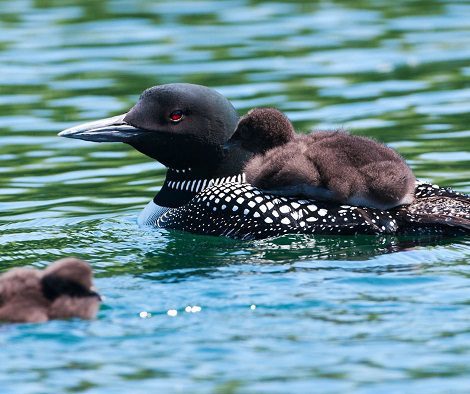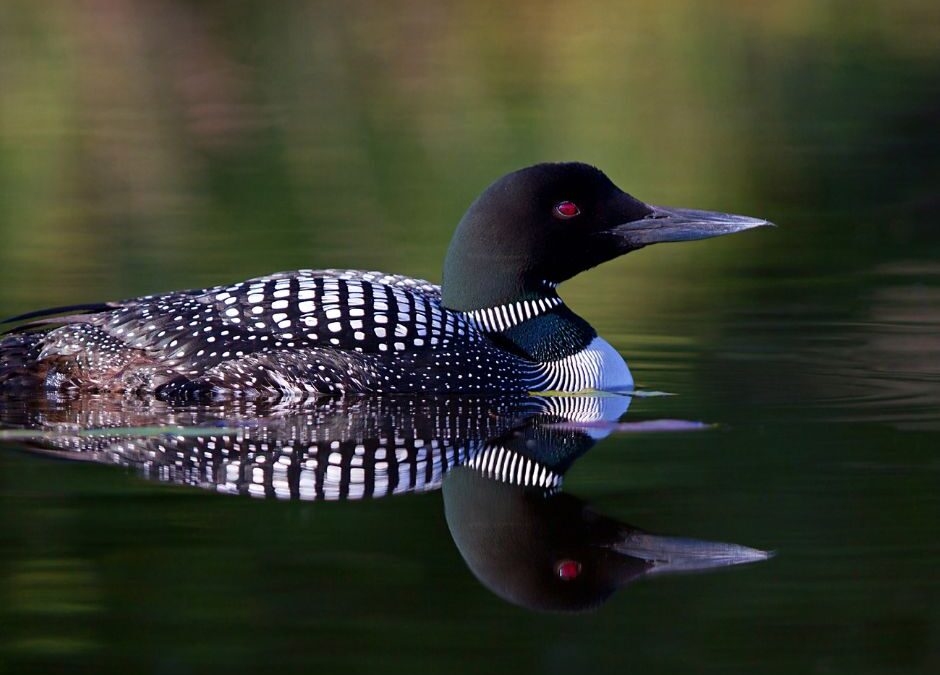According to one LMEF volunteer, he has spotted loons this time of year stopping for a brief time at Lake Maxinkuckee during their migration to their more northern breeding grounds. They are excellent indicators of water quality because they require clear water with abundant populations of small fish.
David Evers, founder and executive director of the Biodiversity Research Institute says:
“Loons are like eagles. Everybody loves them. It’s one of those highly recognizable species that would bring value to people’s lives, and an animal that people could rally around as a conservation symbol.”
The Best Fun Fact About Loons
A group of loons is called an asylum!
Back in July 2010, the Concord Monitor was doing a story about loon conservation on Lake Winnipesaukee when reporter Madeline Buckley asked Loon Preservation Committee biologist Vincent Spagnuolo what to call a group of these lovely water birds.
“Usually you don’t refer to groups of loons that often, because they’re highly territorial and you don’t see them in groups much,” Spagnuolo recalled this week. “I jokingly said ‘an asylum.’ ”
It seems to have stuck!
Nesting
Loons nest in quiet, protected, hidden spots of the lakeshore, typically in the lee (facing away from the wind) of islands or in a sheltered back bay. Loons can’t walk well on land, so nests are built close to a bank on a low mass of vegetation near the water. For this reason, areas of the lake with high wave action are not conducive to loon nests. The nests usually contain two olive-brown, lightly spotted eggs and both adults incubate the eggs and share in care of the young.
Loons have also been known to use artificial nesting platforms, which people have offered as alternative habitat on lakes with no good nesting sites or to encourage new loon populations where there are none. Many times a nesting pair of loons will reuse the same site the following year, refurbishing their old nest instead of building a new one.
Artificial Nesting Platform Information
Hostile Takeovers
Loons first return to the breeding grounds at age 2-5 years. Both males and females tend to wander around and use many different lakes for 2 to 3 years before settling. When 4-5 years old, they usually settle in a vacant territory with a mate and thus found a new territory. If they have not acquired a territory by 6-8 years of age, however, they will attempt to seize a territory from an established owner after a violent and prolonged territorial battle.

About one-third of all territorial takeovers among males result in the death of the displaced male owner.
Piggyback Rides
Loon chicks can swim within a few hours of hatching. Still, they often ride piggyback on their parent. Once a baby loon reaches 4 weeks old it is usually too big for piggyback rides.

Biologists suspect there are two primary reasons for back riding:
Back riding may serve to warm the chick.
Back riding may reduce predation.
During the first week after hatching a chick may spend more than half its time on adults. After a week there is a sharp drop in back-riding.
The Call of the Loon
“No sadder sound salutes you than the clear, wild laughter of the loon. “
— Celia Thaxter American Poet 1835 – 1894
Loon calls are used to communicate among family members and to maintain territories during the breeding season. Adult loons have five basic types of vocalizations;
- Wail
- Hoot
- Yodel
- Tremelo
- Cooing
Populations
Surveys indicate Minnesota has the largest population of common loons with more than 10,000 adults.
According to the North American Breeding Bird Survey, North American Common Loon populations have been stable overall and are of relatively low conservation concern. Regional declines have occurred at the southern edge of their range (Illinois, Indiana, Iowa, and Ohio) and are currently only found in northern areas of Minnesota, Wisconsin, and Michigan (climate change?). Their range has retracted in New England as well, though loon populations have rebounded there thanks to restoration efforts.
Lead fishing sinkers, which loons ingest when they scoop up pebbles off the lake bottom to store in their gizzards, have been a significant cause of loon deaths from lead poisoning. Human activity, particularly motorboats, can also disturb loons on breeding lakes and reduce populations.
Common Loon Resource Brief – National Park Service
Let me know if you hear any loons on Lake Maxinkuckee this spring! Even better, send me some pictures!

Hi, I’m Debbie Palmer. I received a BS in Horticulture from Purdue University. Here at LMEF, I am responsible for outreach presentations, monitoring the lake and it’s wetlands, project manager for restoration and research projects, and act as a community resource for all things related to the well-being of Lake Maxinkuckee and its surrounding watershed. I completed Indiana Watershed Leadership Academy, volunteer with the Indiana Clean Lakes Program, Hoosier River Watch and Marshall County Lakes and Waters and serve as a Board Member for Indiana Lakes Management Society.


Recent Comments